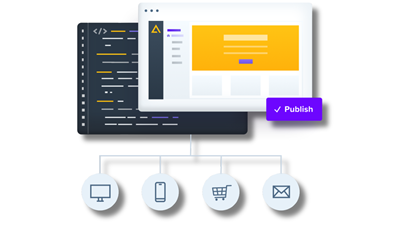What is Structured Content?


For enterprises and organizations, structured content is now crucial to content development. Structured content has emerged as a means of streamlining the content development process and guaranteeing consistency across various channels in response to the growth of digital platforms and the rising demand for high-quality content.
In this post, we will define structured content, look at content structuring, and talk about producing and managing structured content. We'll also offer advice on how to organize material for websites.
A definition of structured content
Content that's organized to be easily reused and repurposed across various channels and platforms is referred to as structured content. It is content written with a particular structure in mind, making it possible to separate it into smaller pieces that can be used in different settings.
Text, graphics, music, and video are just a few formats structured content can take. Structured material is distinct because of how information is arranged and categorized. Metadata is frequently added to structured content, which tells us about the item's format, function, and context.
The author, creation date, and topic of a piece of content are just a few examples of metadata. It may also contain additional details, such as the target audience, the writing style, and the keywords employed.
The main advantage of structured content is that businesses and organizations can reuse and repurpose content across many media and platforms. As a result, the time and resources required to develop fresh material from scratch can be reduced because content can be created once and used often.
Moreover, structured content offers customers a unified experience across all platforms. Businesses can guarantee that their material is displayed consistently and expertly by employing a systematic strategy, regardless of the platform or device used.
What is structured content authoring?
The process of producing structured material is referred to as "structured content authoring." This often entails creating and organizing content in an organized way using a content management system (CMS) or another authoring tool.
Templates, content models, and tools for tagging metadata are features frequently found in structured content authoring systems. These technologies make it easy to develop material systematically and uniformly, facilitating future reuse and repurposing.
Collaboration between various groups of teams and stakeholders is another frequent aspect of structured content development. This may entail collaborating with editors, designers, and subject matter experts to ensure the material is correct, engaging, and aesthetically pleasing.
What is structured content management?
The practice of maintaining and organizing structured content is referred to as structured content management. For this to happen, a Content Platform or other technology is often used to store, organize, and distribute material across many platforms and channels.
Version control, taxonomy management, and content models are common elements of structured content management software. By ensuring that content is arranged in a consistent and manageable manner, these technologies make it simpler to reuse and repurpose the content in the future.
Collaboration between various teams and stakeholders and workflow management are frequently involved in structured content management. This could include organizing content distribution across channels and platforms, handling approvals, and monitoring content updates.
Key aspects and principles of structured content management include:
Content Modularity:
Content is broken down into smaller, self-contained modules or components. These modules can include individual paragraphs, images, product descriptions, videos, and other content elements. Each module is treated as a separate entity that can be managed and reused independently.
Standardized Markup:
Structured content often relies on a consistent and standardized markup or schema, such as XML (eXtensible Markup Language) or JSON (JavaScript Object Notation). This markup provides a clear structure to the content, making it easier to categorize and present in various contexts.
Metadata:
Structured content typically includes metadata that describes the content's attributes, context, and relationships. Metadata can include information about the author, publication date, keywords, and more. This metadata helps with content organization and retrieval.
Content Reusability:
One of the primary benefits of structured content management is the ability to reuse content across multiple channels and platforms. When content is structured and modular, it can be easily repurposed without significant rework.
Adaptability and Responsiveness:
Structured content is well-suited for responsive web design and the delivery of content to various devices and screen sizes. Content can be dynamically adapted to fit different layouts and formats.
Content Personalization:
Structured content can be used as the foundation for content personalization efforts, where different versions of content are served to different audience segments based on their preferences and behaviors.
Content Localization:
Structured content makes it easier to manage multilingual content. Translations can be applied at the module level, ensuring consistency across languages.
Version Control:
Structured content management often includes version control mechanisms, allowing content creators to track changes and revisions over time.
Content Governance:
Organizations can establish content governance policies and workflows to ensure content quality, compliance, and consistency.
How to structure content for websites
1. Create a plan
You should have a strategy before you begin writing content for your website. Creating a content strategy that describes the kinds of material you want to produce, the subjects you want to cover, and the audience you want to reach can fall under this category.
Ensuring your website content aligns with your company's goals and objectives help you stay focused.
2. Use a clear, logical framework
Have a clear and consistent framework when organizing the material for your website. Using headers and subheadings to divide your text into manageable pieces, bullet points and numbered lists to emphasize essential ideas, and photographs and other multimedia components to add visual interest are a few examples of how to do this.
Make your website's material more interesting and straightforward to read for your audience by employing a clear and consistent structure.
3. Be search engine friendly
Optimizing your content for search engines while arranging it for your website is crucial. Use relevant keywords and phrases for your company or industry in your headings, subheadings, and body content to achieve this goal.
Your website can rank better in search engine results pages (SERPs) by optimizing your content for search engines. This will make it simpler for your target audience to find your material.
4. Make it scannable
Most website users scan a page's content rather than reading every word to find the information they require. Use short paragraphs, bold text, and other formatting tricks to break up your material and make it simpler to read at a glance to make your website content more scannable.
5. Prioritize user experience
The ultimate objective of content organization for your website is to give your visitors a satisfying user experience. Making your website's content user-friendly, engaging, and pertinent to your target audience is essential.
Understanding your audience's demands and preferences is crucial for prioritizing user experience. This may entail gathering input from your audience, doing user research, and studying website analytics data.
By prioritizing user experience and following these fundamental principles for structuring content for websites, you can create a website that engages and informs your audience and supports your business goals and objectives.
What Content Could Be Used for a Structured Snippet Extension?
A structured snippet extension is a feature used in online advertising, particularly in pay-per-click (PPC) advertising platforms like Google Ads. It allows advertisers to provide additional information about a product, service, or category in their ads. This additional information is typically displayed in a bullet-point format beneath the main ad text. Structured snippets give users more context and information about what the advertiser offers, potentially increasing the click-through rate (CTR) and the quality of the traffic generated.
Here are some content ideas that can be used for a structured snippet extension:
Product Categories:
If you are an e-commerce retailer, you can use structured snippets to highlight your product categories. For example:
- Electronics
- Home Decor
- Fashion Accessories
- Sports Equipment
Product Types:
If you want to showcase specific types of products within a category, you can list them:
- Laptops
- Sofas
- Necklaces
- Running Shoes
Services:
If you offer services, you can use structured snippets to highlight the different services you provide:
- Web Design
- SEO Optimization
- Content Writing
- Social Media Marketing
Features:
Highlight key features or attributes of your products or services:
- Free Shipping
- 24/7 Customer Support
- Money-Back Guarantee
- Eco-Friendly
When creating structured snippets, it's essential to choose content that is relevant to the ad and provides value to the user. The information should be concise and align with the user's intent and the overall message of the ad campaign. Experimenting with different structured snippet content can help you determine what resonates best with your target audience and leads to higher CTRs and conversion rates.

About the Author
Harmonie is the Senior Marketing Manager at Agility CMS



